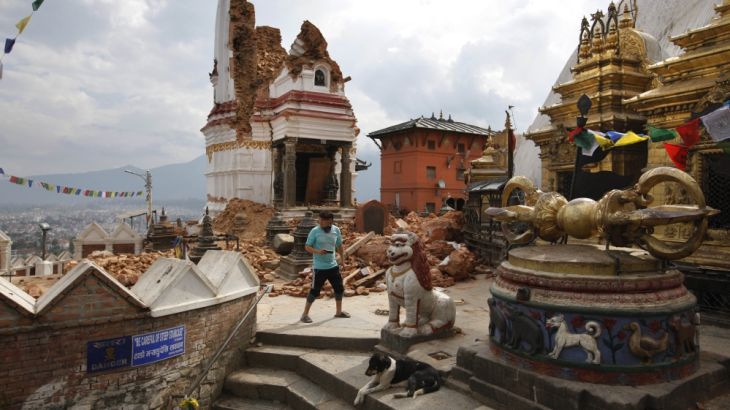Nepal rules out finding survivors as quake toll rises
No signs of life in rubble since Thursday, as toll climbs past 7,000 deaths with more than 14,100 injured.

Eight days after a magnitude 7.8 earthquake hit Nepal, police said the known death toll from the disaster has climbed to 7,040 people, with the government ruling out finding more survivors despite relatives refusing to give up hope.
National police officer Babu Kanji Giri told the Associated Press news agency on Sunday that the death toll had reached 7,040 as more bodies were found in the debris.
Keep reading
list of 4 itemsThe everyday items you never knew contained plastic
‘Don’t be afraid for the marshes’: The battle to save Iraq’s waterways
Why has the flooding in Kenya been so devastating?
The number of injured has climbed to 14,123.
On Saturday, home ministry spokesman Laxmi Prasad Dhakal said there was little hope of finding more survivors.
“We are trying our best in rescue and relief work but now I don’t think that there is any possibility of survivors under the rubble,” Dhakal told the AFP news agency.
While multiple teams of rescuers from more than 20 countries have been using sniffer dogs and heat-seeking equipment to find survivors in the rubble, no one has been pulled alive since Thursday night.
|
|
Late on Saturday afternoon, dozens of Nepalese gathered in capital Kathmandu’s Maitighar Mandala Park to recite a prayer and light candles for those who perished in the earthquake.
Authorities were also reporting that a magnitude 5.1 aftershock was recorded late on Saturday, according to Al Jazeera’s Andrew Simmons, who is reporting from Kathmandu.
The cost of the damage is expected to exceed $10bn: remote towns and villages have yet to be reached to assess the devastation there.
“There’s a crying need for more action,” our correspondent said, saying that in some remote regions, help was still limited.
Two days after any signs of life had been detected among the mountains of rubble that litter the capital, the focus was shifting to reaching survivors in far-flung areas who have yet to receive relief supplies.
Outbreak of diseases
The UN children’s fund UNICEF warned of a race against time to avert an outbreak of disease among the 1.7 million youngsters estimated to be living in the worst-hit areas, with monsoon rains just a few weeks away.
Gary Shaye, of the NGO Save The Children, told Al Jazeera that Nepal would need a “multi-year programme” to recover from the disaster.
|
|
Al Jazeera’s Subina Shrestha, reporting from the village of Dukuchap in Lalitpur area, said on Friday that locals were suffering from diarrhoea, stomach cramps and other diseases that could turn into epidemics if the cause of the problem was not stopped in time.
“The water is thick and smelly, but we have to drink it,” Kalpana Tamang, a Dukuchap village resident, told Al Jazeera.
Dr Kishore Rana, a major general in the Nepalese army, said that in a number of villages the health centres and hospitals have been ruined and the areas depended on mobile medical teams – often foreigners.
“Our plan is for other medical teams that can come here and stay here for a longer duration – three to six months,” he said.
The quake wreaked a trail of death and destruction when it erupted on April 25, reducing much of Kathmandu to rubble and triggering a deadly avalanche on Mount Everest.
More than 100 were also killed in India and China.